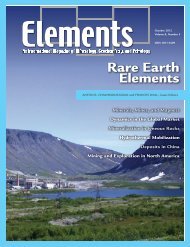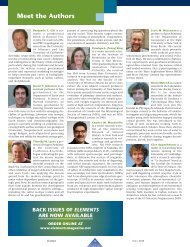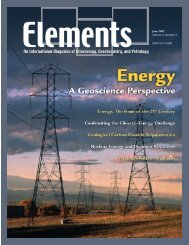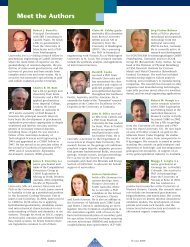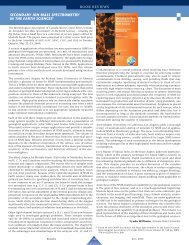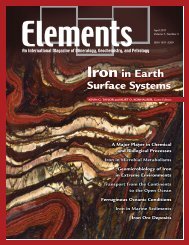Nanogeoscience - Elements
Nanogeoscience - Elements
Nanogeoscience - Elements
Create successful ePaper yourself
Turn your PDF publications into a flip-book with our unique Google optimized e-Paper software.
ET ALII<br />
This past winter, I was invited by one of our undergraduates to participate<br />
in a student government symposium on scientifi c integrity. I<br />
joined colleagues from natural science departments on a panel to discuss<br />
scientifi c integrity and take questions from students. To my surprise,<br />
most of the discussion was about lab reports. The students do<br />
the laboratory exercises as a team but write separate reports. They are<br />
graded as individuals. The concern was about how to evaluate the work<br />
of an individual in the collective effort. The physics department had<br />
the ultimate weapon, a computer algorithm that compares<br />
all laboratory reports, past and present, sniffi ng<br />
out any evidence of plagiarism. Still, some students,<br />
several percent, take their chance, copy old reports, and<br />
test the power of the algorithm. When the evening<br />
ended, I thought that we had become part of the<br />
problem. Rather than focusing on how lab reports are<br />
graded, we had missed the perfect opportunity to discuss<br />
the role of teamwork and collaboration in modern<br />
science.<br />
Collaborations consisting of large, multidisciplinary teams of scientists<br />
and engineers have become a hallmark of modern science. Complex<br />
scientifi c problems, such as the causes and impacts of climate change,<br />
require teams that can bring a wide variety of skills, experience, and<br />
perspectives to bear on these grand issues. Increasingly, funding agencies<br />
stimulate these collaborations with investments in centers and<br />
institutes rather than in individual principal investigators. The<br />
Intergovernmental Panel on Climate Change called on over 1200 lead<br />
and contributing authors over six years to create their three-volume<br />
4 th assessment report. The IPCC is, perhaps, an unusual example, but<br />
the trend towards increased collaboration is science-wide and most<br />
evident in “big” science. A single paper describing the ATLAS detector<br />
for the Large Hadron Collider at CERN weighed in at 3522 authors (13<br />
pages were required to list all of the authors). Other joint efforts, such<br />
as the sequencing of genomes, require hundreds of authors: 468 for<br />
the mouse (Nature, 2002, 420: 520-560) and 338 for rice (Science, 2002,<br />
296: 79-92). Large-scale medical trials, galactic-scale surveys, and planetary<br />
exploration typically require from 50 to 900 authors. Based on<br />
ISI statistics (see ScienceWatch, 2004, July/August), there was a steep<br />
increase in the early 1990s in the number of papers in the physical<br />
sciences with fi fty to one hundred authors. In 1990, the mean number<br />
of authors was 2.6, and in 2003, it was 3.6. During that same period<br />
the number of single-author papers declined from 38% to 25%. Nature<br />
reports that during the fi rst nine months of 2008, there were only six<br />
single-author papers among some 700 reports (Nature, 455: 720-723).<br />
On a smaller scale are papers with fewer than 50 authors, and for these<br />
papers one might imagine that all of the authors have at least met. In<br />
TRIPLE POINT<br />
How many<br />
authors does it take<br />
to write a paper?<br />
the geosciences, the number of authors is usually at this scale: 52 for<br />
deep-sea ocean drilling (Science, 2006, 312: 1016-1020) and 33 for water<br />
on Mars (Science, 2007, 317: 1706-1709), to give just two examples.<br />
What is one to make of the growing number of authors on each paper?<br />
How many authors does it take to write a paper? What “credit” should<br />
each receive from the collective effort? On the positive side of the<br />
ledger, which greatly outweighs the negative, this trend represents the<br />
best effort of scientists grappling with increasingly complex problems<br />
that require the collective skills of many. With the proliferation of<br />
advanced analytical techniques and increasingly sophisticated computational<br />
methods, it is the exceptional scientist who has all of the<br />
equipment or intellectual skills required to address even relatively<br />
“small” scientifi c questions. There are, however, negatives, such as the<br />
ill-named concept of “honorary” authorship (there is no honor in honorary<br />
authorship) and the diffi culty of determining responsibility for<br />
error, as well as success. This leaves institutions struggling with the<br />
apportionment of “credit” as they conduct their annual reviews—the<br />
same problem that professors had in grading laboratory reports.<br />
Universities quantify and confuse, using algorithms that count citations,<br />
and they apportion credit based on the number of authors (fewer<br />
is better) and position in the sequence of authors (fi rst, second, and<br />
last seem to be preferred; see Science, 2008, 322: 371). I have even listened<br />
to a vice-president for research encourage junior faculty to enter<br />
into collaborative, high-risk, multidisciplinary research, with the serious<br />
assurance that their individual contributions can be extracted from<br />
the whole at the time of the tenure decision.<br />
This dissection of teamwork into individual contributions is the antithesis<br />
of a good team-building philosophy. In parallel with the growth<br />
in team science, we need new rules and measures of success. Here sports<br />
provide guidance. Red Auerbach, with his victory cigar, led the Boston<br />
Celtics to nine NBA championships as a coach and<br />
seven more as general manager and team president. He<br />
changed modern basketball by emphasizing team play<br />
over the accomplishments of the individual. At a<br />
moment when the great center Bill Russell was struggling<br />
on court, Auerbach promised him that at the end<br />
of the year, during contract negotiations, Auerbach<br />
would not count the number of goals scored by Russell,<br />
but rather the number of games won by the Celtics.<br />
The rest is history. Bill Russell became one of the game’s greatest defensive<br />
players (21,620 rebounds) but also scored 14,522 career points.<br />
Russell finished his career with 11 NBA championships. Wilt<br />
Chamberlain, Russell’s long-time rival, scored 31,419 points (4 th all-time<br />
record), but had only two NBA championships. Teamwork prevailed<br />
over individual talent. Universities and professional societies with their<br />
individual awards and medals are not well suited for recognizing good<br />
team science. Individual scientists are rarely credited for their team’s<br />
success, only their individual contributions. Academic mentors caution<br />
against too much collaboration prior to the tenure decision. From a<br />
scientist’s earliest days as a student writing a laboratory report until<br />
tenure, the system discourages collaboration.<br />
There must be a better way. Rather than insisting on separate laboratory<br />
reports, the evening’s discussion of scientifi c integrity might have been<br />
an opportunity to discuss the obligations and benefi ts of being a team<br />
member (see “Group Theory,” Nature, 2008, 455: 720-723). The students<br />
could have grappled with the common problem of the “weak” team<br />
member, and they could have argued over the sequence of authors on<br />
the lab report. Such discussion would inform our own perspectives of<br />
what it means to be a coauthor. Some journals, like Nature, require a<br />
clear statement of the contribution of each author as part of the publication<br />
process. This is a fi rst step, but a step still focused on the<br />
individual contribution—not the impact or importance of the team.<br />
ELEMENTS 367<br />
DECEMBER 2008<br />
Rod Ewing<br />
University of Michigan<br />
(rodewing@umich.edu)



